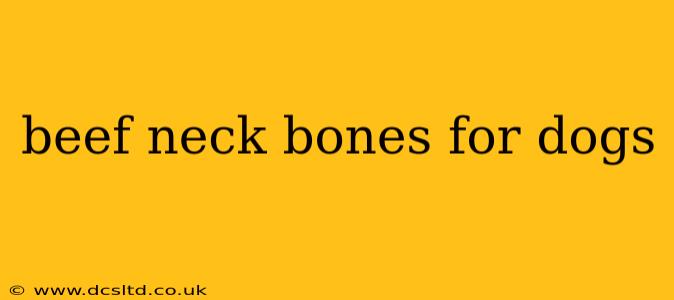Beef neck bones are a popular treat for dogs, offering a delicious chew and a range of potential health benefits. However, it's crucial to understand the pros, cons, and safety precautions before offering them to your canine companion. This comprehensive guide will delve into everything you need to know about beef neck bones for dogs, answering common questions and ensuring your furry friend enjoys this treat safely and responsibly.
Are Beef Neck Bones Safe for Dogs?
The safety of beef neck bones depends heavily on how they are sourced and prepared. Bones from reputable butcher shops or suppliers, properly cleaned and free of splinters, generally pose minimal risk. However, cooked bones are significantly more brittle and prone to splintering, posing a choking hazard and potentially causing internal damage. Always opt for raw, uncooked beef neck bones. Even then, supervision is key.
What are the Benefits of Beef Neck Bones for Dogs?
Raw beef neck bones offer several advantages for dogs:
- Dental Cleaning: The chewing action helps scrape plaque and tartar from teeth, promoting better dental hygiene.
- Mental Stimulation: Chewing provides mental enrichment and can alleviate boredom.
- Nutrient-Rich: Bones provide a natural source of calcium and other minerals, although they shouldn't be considered a primary source of nutrition.
- Joint Support: Some believe the cartilage and bone marrow contribute to joint health, though more research is needed.
What are the Risks of Giving Beef Neck Bones to Dogs?
Despite the potential benefits, there are risks associated with beef neck bones:
- Choking Hazard: Large pieces can pose a choking risk, especially for smaller breeds. Always supervise your dog while they are chewing.
- Splintering: Cooked or improperly handled bones can splinter, causing internal injuries.
- Bacterial Contamination: Raw bones carry a risk of bacterial contamination. Source bones from reputable butchers and ensure proper hygiene.
- Digestive Upset: In some dogs, large amounts of bone can cause digestive upset.
How Often Should I Give My Dog Beef Neck Bones?
The frequency depends on your dog's size, chewing habits, and the size of the bone. Start with smaller bones and closely monitor your dog. A good rule of thumb is to offer a bone as an occasional treat, not a regular part of their diet. Too many bones can lead to constipation or other digestive problems.
What Size Beef Neck Bone Should I Choose for My Dog?
Choose a bone appropriately sized for your dog. Small breeds should only receive small bones, while large breeds can handle larger ones. The bone should be too large to swallow whole but small enough to manage comfortably.
Can Puppies Eat Beef Neck Bones?
Generally, it's best to avoid giving beef neck bones to puppies. Their teeth and jaws are still developing, and they may not be able to handle the chewing effectively, increasing the risk of injury.
What if My Dog Swallows a Large Piece of Beef Neck Bone?
If your dog swallows a large piece of bone, monitor them closely for signs of distress, such as vomiting, difficulty breathing, or lethargy. If you suspect a blockage, contact your veterinarian immediately.
Are There Alternatives to Beef Neck Bones?
Other safe and healthy chew options for dogs include:
- Beef trachea: Offers a similar chewing experience.
- Dental chews: Many commercially available options are designed to promote dental health.
- Nylabones: Durable and long-lasting synthetic chews.
Remember, responsible pet ownership includes making informed decisions about your dog's diet and treats. Always supervise your dog while they chew on bones, and consult your veterinarian if you have any concerns. This information is for general guidance only and does not constitute veterinary advice. Always consult with your veterinarian regarding your pet’s specific needs and health.
